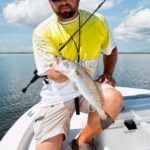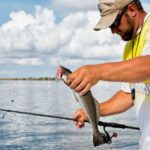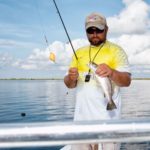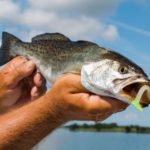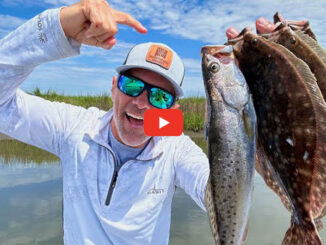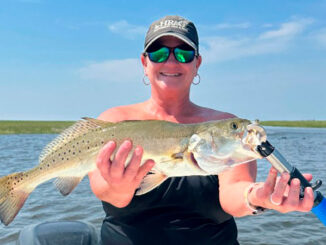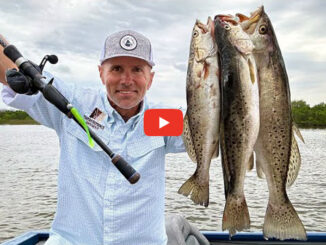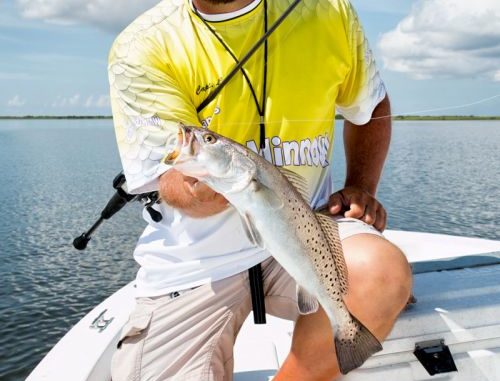
Sure, you could head to Barataria Bay to catch some speckled trout this month. Or you could stay close to Lafitte and spend the day fishing instead of burning gas — and you’ll come home with plenty of fish.
There is absolutely no reason whatsoever to drive past fish to find fish. That’s why Capt. Lane Zimmer is so excited about fishing out of Lafitte during March.
“Oh, there are trout to be caught down south,” Zimmer said, “but why would I want to drive all that far when there are plenty trout here, basically right out our back door?”
And the lack of action the last couple of spring seasons because of some late cold has Zimmer rejoicing over this year’s mild conditions that make him believe trout fishing will exceed even his lofty expectations.
“Once it got cold the last few years, the fishing really slacked off,” he said. “But with the number of trout we’ve been catching throughout the fall and winter, and the warm weather we’ve had, I’m ready for March because we’re still going to have all those fish that were already in the marsh coupled with a push of trout that will follow the brown shrimp on their way in from the Gulf.
“They’re all going to be ready to eat,”
He expects the conglomeration of trout that wintered near Lafitte and those moving up from the Gulf to push as far north as The Pen and Lake Salvador, if there is a big push with some south wind and good salty water.
“In that case, there will be shrimp and trout all over the place,” Zimmer said.
Now you understand why Zimmer (504-689-2006) sees no reason to run down into Barataria Bay just to find fish: He knows trout are there, but it’s so much easier for him to stay close than burn a bunch of gas just to battle unpredictable open water to catch trout.
Of course, the entire key to this fast action is for Mother Nature to continue smiling her good fortune on South Louisiana.
As in previous years, late-season cold fronts could destroy Zimmer’s excitement.
“It also going to be dependent on the brown shrimp migration,” he said. “They sometimes show up in February, depending on the weather. They move in where they do all their growing before moving back out in May.
“When those little shrimp start coming out the marsh, the trout start looking for them.”
But the guide doesn’t have to wait until May for the shrimp to come out of the marsh, since they will typically move out of inaccessible places anytime the tide is falling.
Zimmer looks for spots where water is coming out of little ponds and broken marsh — somewhere there’s any kind of little drain.
In these kinds of spots, trout stack up and feed on shrimp pulled out with the tide.
“I’m going to be in The Pen, Bayou Rigoletts, Bay Round and some days the south end of Little Lake,” Zimmer said. “But you’ve got to pick the right day to fish the bottom of Little Lake. When we have a lot of north wind, all the areas on the south end of Little Lake — places like Brusle, Plum Point and Coffee Bay — get hit with waves pretty hard, and it dirties up the water.”
That doesn’t mean the trout move entirely, but it does mean it makes these southern spots very difficult to fish.
“When we get a south or a southeast wind,” Zimmer said, “that south shore will calm down and clear up, and the shrimp will be pulling out of the marsh there, as well.”
As he mentioned, Zimmer prefers a falling tide because that is when all the stuff in the marsh drains out, making shrimp easy meals for trout — and trout an easy target for anglers.
“When it’s rising, you can still catch but not in as many spots as when it’s falling,” Zimmer said. “A rising tide orients the trout more inward than outward on those drains, and some of the spots they set up on during a rising tide are just about impossible to fish.
“A falling tide basically concentrates trout in spots that are easy to fish.”
The best bite depends on the weather just as it much as it does the tide.
If it’s really cool in the morning, Zimmer waits until it warms up, regardless of the tide, as the area is still breaking free from winter when trout mainly bite on the warmer days.
If Lafitte has been in the middle of a warming trend, he prefers to focus more on the falling tide since trout are more apt to bite in the morning if the tide was right.
Although trout are easy to get to when they stack up like this, that doesn’t mean Zimmer just runs right up in the middle of everything and starts fishing.
Rather, he approaches each drain maybe 75 to 100 yards upwind, if possible, and stealthily fishes from this outer edge toward the drain until he starts catching fish.
“I get up on the bank and fish toward the drain, throwing back toward the drain on both sides of the boat,” Zimmer explained. “I then work the other side, if possible, if I haven’t found any fish yet.
“The whole time, I’m trying to determine if the fish are set up in the current, on the edge or on the bank.”
The last thing Zimmer wants to do is run over the top of a school of trout with the big motor while trying to get right in the mouth of the drain. If you do run over them, you’re going to spook every fish there and ruin your chances of catching fish.
The right tools
Zimmer suggested starting with a popping cork, as that is usually the most effective way to catch them, considering trout are focused on eating shrimp.
“I’ll throw something on the bottom if I’m in a deeper cut,” he said, “and let it work with the tide on its way out.”
Under an H&K TKO cork, the angler ties on either a brown shrimp or limetreuse Ghost Minnow on a 2-foot leader. If he goes to the bottom, Zimmer goes with a lemon peel or chicken on a chain Mad Mullet to get a little bit more swimming action.
Although there are lots of drains to fish around Lafitte, he said the presence of white clam shells on the bottom can turn what looks like just another spot into a potential hotspot.
“A lot of times the trout are on these shell bottoms,” Zimmer explained. “You can tell you’re on top of them if you throw your anchor out or drop your Power-Poles and can hear either scraping through the shells.
“You know you’re in the right spot when you start grinding through all that stuff.”
Don’t expect to catch a bunch of big trout, though. Zimmer sets his expectations each trip toward catching a mixed box of trout ranging from 12 to 18 inches.
“We had a lot of little trout hanging out around Lafitte this winter,” he said. “Those fish should start to be keeper-sized trout by March.
“If that’s what happens, catching a bunch of keepers shouldn’t be any problem at all.”
He also advised anglers to be aware of the water temperature.
“People need to keep an eye on it,” Zimmer said. “For trout, anything above 55 degrees you ought to be able to catch them if the temperature trend is on the upswing. As the water warms up, typically the bite is going to get better.
“If a front hits and the temperature plunges, you’re probably going to have a slow or no bite, even if the tide is right. Trout don’t want to be feeding in that cold water.”
If you’ve ever driven past a restaurant at which you thought about stopping, only to find that there are no or worse options on down the road, you know all you need to know about Zimmer’s approach to trout fishing out of Lafitte this month.
You drove by an opportunity to grab a great meal in hopes that something better would appear down the road — when all you really needed to do to get full was to pull over and stop at the first restaurant.
But, no, you had to drive past food to find food.
According to Zimmer, driving past trout to find trout at Lafitte could lead to the same disappointment down the bayou.
“You may find something better,” he said, “but you may realize that you wasted your time and your opportunity.
And out of Lafitte, there’s no better opportunity for catching trout during March than staying close and catching rather than running far and fishing.
By the time everybody who ran south returns to the dock, you’ll be cleaned up, well fed and taking a nap.
The close call is an easy one to make.
